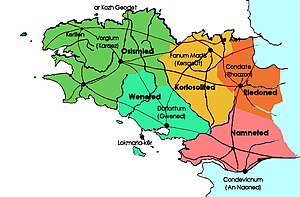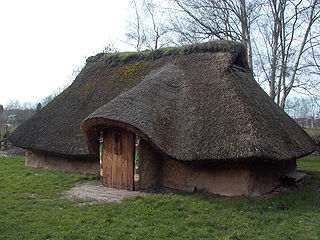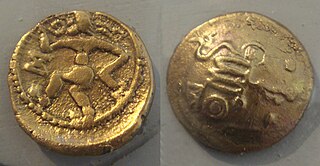
The Osismii, Ossismii, or Ostimii (also Ossismi, Osismi) were a Gallic tribe dwelling in the western part of the Armorican Peninsula (modern Brittany) during the Iron Age and the Roman period.

The Osismii, Ossismii, or Ostimii (also Ossismi, Osismi) were a Gallic tribe dwelling in the western part of the Armorican Peninsula (modern Brittany) during the Iron Age and the Roman period.
They are mentioned as Osismos and Osismi (var.ossismi) by Caesar (mid-1st c. BC), [1] O̓sísmioi (Ὀσίσμιοι) by Strabo (early 1st c. AD), [2] Ossismos by Pliny (1st c. AD), [3] O̓sismíous (Ὀσισμίους; var. Ὀσίσμιοι, Ὀσισμαίους) by Ptolemy (2nd c. AD), [4] and as Osismis in the Notitia Dignitatum (5th c. AD). [5] [6] According to Strabo, the Massaliote explorer Pytheas, who travelled to northwestern Europe in the late 4th century BC, reported the variant Ōstimíous (Ὠστιμίους), which seems to be the earliest attested form of the name, documented before the Gaulish sound shift -st- > -ss- occurred. [7]
Secondly, there are the Osismii (whom Pytheas calls the Ostimii), who live on a promontory that projects quite far out into the ocean, though not so far as he and those who have trusted him say.
The Gaulish ethnonym Ostim(i)i (sing.Ostim(i)os) literally means 'the ultimate', that is to say 'the remotest people', 'those who dwell at the extremity of the Armorican Peninsula'. It derives from the Celtic stem ostim- ('ultimate, extreme'), itself from an earlier *postim- ('last'; cf. Lat. postumus 'last-born, final'). In Middle French, the territory they occupied was known as (Fine) Posterne. [7]

The territory of the Osismii was located at the extremity of the Brittany Peninsula, west of the Veneti and Coriosolites. [8]
Pytheas situated the Osismii at the end of the peninsula of Kabaïon, which is not clearly identifiable today. This could be related to large peninsula of Cap-Sizun , on the southern-western coast of Finistère, just before reaching the difficult maritime pass of Pointe du Raz where the waters of the Atlantic Ocean and of the English channel are joining; this peninsula offers to the south a natural safe harbour in the aber and bay of today's town of Audierne, as well as in the bay of today's Douarnenez, to the north of the peninsula. Other hypotheses situate it in the small peninsula of Kermorvan in today's commune of Ploumoguer and bordering the ria of Le Conquet, but the whole peninsula of Crozon with its large bays and safe harbors is not excluded, even if it does not extend to the westernmost point.[ citation needed ]
They submitted to Caesar during the Gallic Wars, in 58 BC, but took part in an insurrection against Rome in 56 BC. [8]

The Menapii were a Belgic tribe dwelling near the North Sea, around present-day Cassel, during the Iron Age and the Roman period.

The Lingones were a Gallic tribe of the Iron Age and Roman periods. They dwelled in the region surrounding the present-day city of Langres, between the provinces of Gallia Lugdunensis and Gallia Belgica.

The Carnutes or Carnuti, were a Gallic tribe dwelling in an extensive territory between the Sequana (Seine) and the Liger (Loire) rivers during the Iron Age and the Roman period.

The Morini were a Belgic coastal tribe dwelling in the modern Pas de Calais region, around present-day Boulogne-sur-Mer, during the Iron Age and the Roman period.

The Venetī were a Gallic tribe dwelling in Armorica, in the northern part of the Brittany Peninsula, during the Iron Age and the Roman period.

The Vellavii were a Gallic tribe dwelling around the modern city of Le Puy-en-Velay, in the region of the Auvergne, during the Iron Age and the Roman period.

The Pictones were a Gallic tribe dwelling south of the Loire river, in the modern departments of Vendée, Deux-Sèvres and Vienne, during the Iron Age and Roman period.

The Aulerci Cenomani were a Gallic tribe dwelling in the modern Sarthe department during the Iron Age and the Roman period. The Cenomani were the most powerful of the Aulerci tribes.

The Petrocorii were a Gallic tribe dwelling in the present-day Périgord region, between the Dordogne and Vézère rivers, during the Iron Age and the Roman period.

The Parisii were a Gallic tribe that dwelt on the banks of the river Seine during the Iron Age and the Roman era. They lived on lands now occupied by the modern city of Paris, whose name is derived from the ethnonym.
The Caletes or Caleti were a Belgic or Gallic tribe dwelling in Pays de Caux, in present-day Normandy, during the Iron Age and the Roman period.
The Lexovii, were a Gallic tribe dwelling immediately west of the mouth of the Seine, around present-day Lisieux, during the Iron Age and the Roman period.

The Ambiani were a Belgic coastal tribe dwelling in the modern Picardy region during the Iron Age and Roman periods.
The Nantuates or Nantuatae were a Gallic tribe dwelling around present-day Massongex, in the modern Canton of Valais (Switzerland) and adjacent areas of France, during the Iron Age and the Roman period.

The Redones or Riedones were a Gallic tribe dwelling in the eastern part of the Brittany peninsula during the Iron age and subsequent Roman conquest of Gaul. Their capital was at Condate, the site of modern day Rennes.

The Andecavi were a Gallic tribe dwelling in Aremorica during the Roman period.

The Gabali were a Gallic tribe dwelling in the later Gévaudan region during the Iron Age and the Roman period.

The Namnetes were a Gallic tribe dwelling near the modern city of Nantes during the Iron Age and the Roman period.

The Segusiavī were a Gallic tribe dwelling around the modern city of Feurs (Auvergne-Rhône-Alpes) during the Iron Age and the Roman period.

The Cadurci were a Gallic tribe dwelling in the later region of Quercy during the Iron Age and the Roman period.